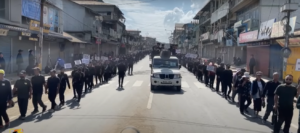Unau is your digital destination for celebrating the essence of brotherhood across the Kuki, Mizo, Zomi, and Hmar tribes.
Amid ongoing negotiations with the Union Home Ministry, Kuki-Zo militant groups have put forward a bold demand for the establishment of a union territory similar to the administrative structure of Puducherry.
The groups, which had signed a ceasefire agreement with the Manipur and Central governments in 2008, believe that a separate administration for their community is the key to resolving the ongoing unrest between Meiteis and Kukis in Manipur.
The violence that erupted in Manipur in May has led to over 170 casualties and the displacement of thousands. Tribal communities, particularly those residing in five districts—Churachandpur, Kangpokpi, Chandel, Tengnoupal, and Pherzawl—have been advocating for a separate administration.
In Delhi, four rounds of talks were held on July 16, August 17, August 31, and September 1 between the Union Home Ministry’s Northeast Advisor, AK Mishra, and the Kuki National Organization (KNO) and United People’s Front (UPF). These two umbrella militant groups encompass a total of 19 outfits, with KNO comprising 11 and UPF comprising eight, as per the 2008 Suspension of Operations agreement.
During their last meeting with Mishra on September 1, both groups submitted a “charter of demands.” It remains unclear when the next meeting will occur, but one source suggested that it was postponed due to the G20 summit and a special Parliament session this month.
“The file has been forwarded by Mishra to Home Minister Amit Shah,” revealed one source.
The Kuki-Zo groups are advocating for direct governance by the Central government, possibly through a lieutenant governor with provisions for a council of ministers, similar to Article 239A in the Constitution. Article 239A, introduced after the 14th constitutional amendment, deals with the establishment of Puducherry, making it the only Union Territory, apart from Delhi, with an elected government.

One of the reasons cited for referring to the Puducherry model is the non-contiguous nature of the five districts that would require a “separate administration.” Tengnoupal and Chandel are located in the eastern and southeastern parts of the state, while Kangpokpi is closer to the center. This geographical disparity is reminiscent of Puducherry, which comprises four non-contiguous districts scattered near Tamil Nadu, Kerala, and Andhra Pradesh.
One source highlighted the Central government’s delayed efforts in finding a political solution, urging that “the government should take suo motu action [in cases of injustice], just as the courts can. It’s been almost five months since the violence. If the Center does not assist, what’s the point of its existence?”
The source emphasized that the demand for a separate administration is not a matter of concession but a necessity.
Notably, the source claimed that the Kuki insurgent groups had initially made demands that shifted once the violence began in May. Allegedly, the Home Ministry had “orally agreed” to establish an autonomous territorial council for hill districts under the Sixth Schedule of the Constitution, with a final approval scheduled for May 8. However, discussions broke down when violence erupted on May 3.
The territorial claims of the Kukis overlap with areas claimed by the Nagas. Of the ten hill districts in Manipur, five are reportedly dominated by the Kukis, while the rest are predominantly Naga. The source suggested that if the Nagas wish to join such a Union Territory, they are welcome, but they could also seek a separate Union Territory for their five districts.
Among the five districts sought by the Kuki-Zo community, Nagas claim three: Kangpokpi, Chandel, and Tengnoupal. A spokesperson for the Government of the People’s Republic of Nagalim (GPRN), a parallel government run by the National Socialist Council of Nagaland (Isak-Muivah), stated that these three districts belong to the Nagas and should not be part of a separate administration.
The GPRN has been engaged in peace talks with the Central government since signing a framework agreement in 2015, seeking the sovereign state of Nagalim, which would encompass areas in Assam, Arunachal Pradesh, Manipur, and part of Myanmar.
While the GPRN spokesperson did not specify whether the Nagas had been consulted regarding the Kuki’s “charter of demands,” they insisted that “not an inch of Naga territory should be touched.”








